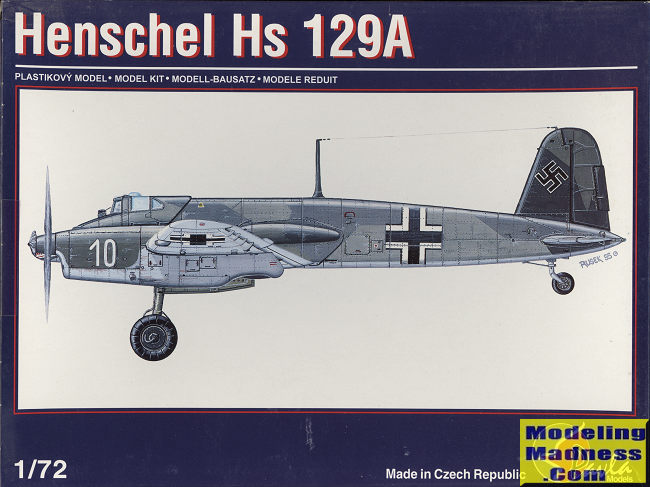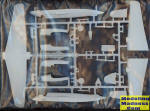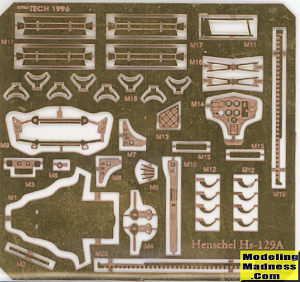
Pavla 1/72 Hs-129A
| KIT #: | 72004 |
| PRICE: | $ |
| DECALS: | Two options |
| REVIEWER: | Scott Van Aken |
| NOTES: | Short run with vac canopies and photo etch. |

| HISTORY |
The Henschel Hs 129 was a World War II ground-attack aircraft fielded by the German Luftwaffe. The aircraft saw combat in Tunisia and on the Eastern Front.
A key requirement of the original specification was that the aircraft be powered by engines that were not in demand for other designs. Prototypes with low-power German Argus As 410 engines of 465 PS (459 hp; 342 kW) failed acceptance test, a more powerful replacement was found with the French Gnome-Rhône 14M engine of 700 PS (690 hp; 515 kW). All Hs-129A aircraft were eventually used in training units while some were converted to the later B model.
The design was relatively effective when it was first introduced, and saw service on the Eastern Front in a variety of front-line roles. As the war continued and anti-tank support became the main goal, the aircraft was continually up-gunned, eventually mounting a 75 mm anti-tank gun. Only a small number of these B-3 models were produced, late in the war.
| THE KIT |
 Pavla
was well known for producing limited run kits of subjects that were not
produced by mainstream model companies. Though a few have since been
done by larger companies, many are still only available in Pavla boxes.
This is one of them.
Pavla
was well known for producing limited run kits of subjects that were not
produced by mainstream model companies. Though a few have since been
done by larger companies, many are still only available in Pavla boxes.
This is one of them.
The kit provides a single plastic sprue, two vacuform canopies, a photo etch fret and an acetate sheet with instruments. These latter items are to be fitted under p.e. panels and attached to the inside of each engine nacelle as there was no room in the cockpit for engine instruments.
 The
plastic is lightly engraved and all of the parts show some degree of
flash. Large parts have quite a few ejection towers, many of which will
need to be removed to build the kit. Aside from the seat shape, control
column and floor, all the interior parts are photo etch. This includes
the seat armor and the seat mounting framework.
The
plastic is lightly engraved and all of the parts show some degree of
flash. Large parts have quite a few ejection towers, many of which will
need to be removed to build the kit. Aside from the seat shape, control
column and floor, all the interior parts are photo etch. This includes
the seat armor and the seat mounting framework.
With the interior built up, it is trapped between the fuselage halves at which time the horizontal stabls, fin, and tail wheel are installed. Next the wings are assembled and attached. One then moves to the engine nacelles and props. These are then attached to the fuselage.
Landing gear is next. You are provided the main strut and wheels, but all the retraction struts and other braces will need to be made from stretches sprue. A guide is provided. Also needing installed are four small p.e.aileron hinges per side. Four p.e. bomb racks with shackles fit on the underside between the engines. The vac canopy and other smaller items are then installed. The modeler needs to make the fuselage machine gun barrels.
Pavla's instructions are very good. They provide lots of detail drawings to help with assembly and placement. Though my kit was missing the decals, two near identical schemes were included. Both are in RLM 70/71/65 from 4./SG 101, the training squadron. Despite no decals, the markings should be quite easy to replicate as they are basically insignia and numbers.
| CONCLUSIONS |
Not exactly a kit that draws a lot of modelers, but one that is interesting nonetheless and if you are tired of the usual Spitfires, Mustangs, and 109s, this might well be for you. Not for beginners, but anyone with a decent repertoire of skills should be able to handle it.
| REFERENCES |
https://en.wikipedia.org/wiki/Henschel_Hs_129
November 2022
Copyright ModelingMadness.com. All rights reserved. No reproduction in part or in whole without express permission from the editor.
If you would like your product reviewed fairly and fairly quickly, please contact the editor or see other details in the Note to Contributors.